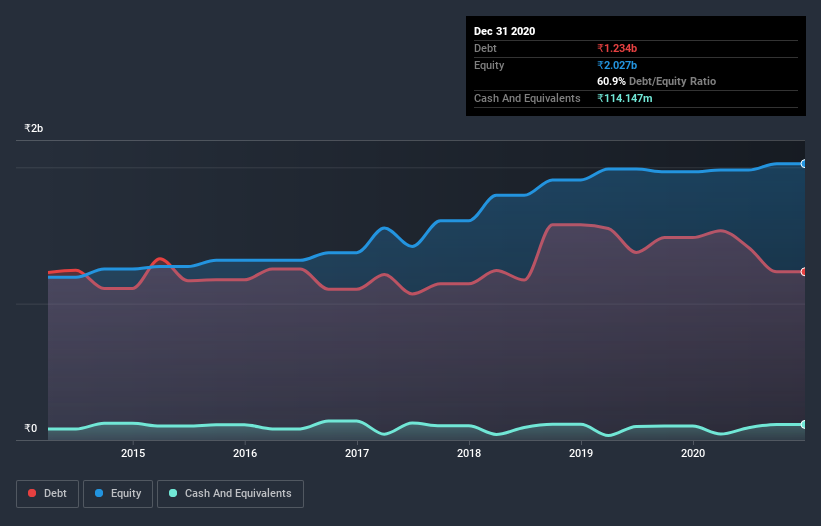- India
- /
- Auto Components
- /
- NSEI:TALBROAUTO
Is Talbros Automotive Components (NSE:TALBROAUTO) Using Too Much Debt?

Warren Buffett famously said, 'Volatility is far from synonymous with risk.' It's only natural to consider a company's balance sheet when you examine how risky it is, since debt is often involved when a business collapses. We can see that Talbros Automotive Components Limited (NSE:TALBROAUTO) does use debt in its business. But the more important question is: how much risk is that debt creating?
Why Does Debt Bring Risk?
Generally speaking, debt only becomes a real problem when a company can't easily pay it off, either by raising capital or with its own cash flow. In the worst case scenario, a company can go bankrupt if it cannot pay its creditors. However, a more common (but still painful) scenario is that it has to raise new equity capital at a low price, thus permanently diluting shareholders. Of course, debt can be an important tool in businesses, particularly capital heavy businesses. The first step when considering a company's debt levels is to consider its cash and debt together.
View our latest analysis for Talbros Automotive Components
What Is Talbros Automotive Components's Debt?
The image below, which you can click on for greater detail, shows that Talbros Automotive Components had debt of ₹1.23b at the end of September 2020, a reduction from ₹1.48b over a year. On the flip side, it has ₹114.1m in cash leading to net debt of about ₹1.12b.

A Look At Talbros Automotive Components' Liabilities
We can see from the most recent balance sheet that Talbros Automotive Components had liabilities of ₹2.44b falling due within a year, and liabilities of ₹303.4m due beyond that. Offsetting this, it had ₹114.1m in cash and ₹1.31b in receivables that were due within 12 months. So its liabilities total ₹1.32b more than the combination of its cash and short-term receivables.
Talbros Automotive Components has a market capitalization of ₹2.62b, so it could very likely raise cash to ameliorate its balance sheet, if the need arose. However, it is still worthwhile taking a close look at its ability to pay off debt.
We use two main ratios to inform us about debt levels relative to earnings. The first is net debt divided by earnings before interest, tax, depreciation, and amortization (EBITDA), while the second is how many times its earnings before interest and tax (EBIT) covers its interest expense (or its interest cover, for short). This way, we consider both the absolute quantum of the debt, as well as the interest rates paid on it.
While Talbros Automotive Components's debt to EBITDA ratio (2.7) suggests that it uses some debt, its interest cover is very weak, at 1.9, suggesting high leverage. So shareholders should probably be aware that interest expenses appear to have really impacted the business lately. Given the debt load, it's hardly ideal that Talbros Automotive Components's EBIT was pretty flat over the last twelve months. When analysing debt levels, the balance sheet is the obvious place to start. But you can't view debt in total isolation; since Talbros Automotive Components will need earnings to service that debt. So when considering debt, it's definitely worth looking at the earnings trend. Click here for an interactive snapshot.
Finally, while the tax-man may adore accounting profits, lenders only accept cold hard cash. So we always check how much of that EBIT is translated into free cash flow. Looking at the most recent three years, Talbros Automotive Components recorded free cash flow of 36% of its EBIT, which is weaker than we'd expect. That weak cash conversion makes it more difficult to handle indebtedness.
Our View
Mulling over Talbros Automotive Components's attempt at covering its interest expense with its EBIT, we're certainly not enthusiastic. But at least its EBIT growth rate is not so bad. Looking at the balance sheet and taking into account all these factors, we do believe that debt is making Talbros Automotive Components stock a bit risky. Some people like that sort of risk, but we're mindful of the potential pitfalls, so we'd probably prefer it carry less debt. There's no doubt that we learn most about debt from the balance sheet. However, not all investment risk resides within the balance sheet - far from it. We've identified 3 warning signs with Talbros Automotive Components (at least 1 which shouldn't be ignored) , and understanding them should be part of your investment process.
At the end of the day, it's often better to focus on companies that are free from net debt. You can access our special list of such companies (all with a track record of profit growth). It's free.
If you decide to trade Talbros Automotive Components, use the lowest-cost* platform that is rated #1 Overall by Barron’s, Interactive Brokers. Trade stocks, options, futures, forex, bonds and funds on 135 markets, all from a single integrated account. Promoted
Valuation is complex, but we're here to simplify it.
Discover if Talbros Automotive Components might be undervalued or overvalued with our detailed analysis, featuring fair value estimates, potential risks, dividends, insider trades, and its financial condition.
Access Free AnalysisThis article by Simply Wall St is general in nature. It does not constitute a recommendation to buy or sell any stock, and does not take account of your objectives, or your financial situation. We aim to bring you long-term focused analysis driven by fundamental data. Note that our analysis may not factor in the latest price-sensitive company announcements or qualitative material. Simply Wall St has no position in any stocks mentioned.
*Interactive Brokers Rated Lowest Cost Broker by StockBrokers.com Annual Online Review 2020
Have feedback on this article? Concerned about the content? Get in touch with us directly. Alternatively, email editorial-team (at) simplywallst.com.
About NSEI:TALBROAUTO
Talbros Automotive Components
Engages in the manufacture and sale of auto components in India.
Flawless balance sheet second-rate dividend payer.
Similar Companies
Market Insights
Community Narratives




